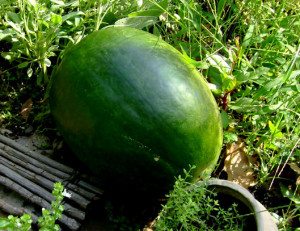 The 40 acres to the left of our house belonged to my aunt and her crew and the field to the right belonged to my dad. Across the way were two fields, each 40 acres. A swamp — really a drainage ditch that got out of control — and a little irrigation ditch separated Daddy’s and my Aunt’s fields from the 80 acres which belonged to another tribal member. At the time I only knew his name was Mingo. And he grew watermelons. Everybody grew watermelons. Some in small gardens, others taking an acre or two to grow their melons which not only included watermelons but cantaloupes, honeydews, cassabas. Mingo only grew watermelons. Nice, ripe, juicy, sweet melons that I can’t seem to find in the stores these days. At least, every watermelon I’ve purchased has been tasteless. But Mingo’s…well, you bust them open, dig out the rich red hearts with your hands and KAPOW! sweetness galore. They were solid green, except for the yellowing which speaks of ripeness. I don’t recall anybody on the reservation growing the striped kind. Maybe some did.
The 40 acres to the left of our house belonged to my aunt and her crew and the field to the right belonged to my dad. Across the way were two fields, each 40 acres. A swamp — really a drainage ditch that got out of control — and a little irrigation ditch separated Daddy’s and my Aunt’s fields from the 80 acres which belonged to another tribal member. At the time I only knew his name was Mingo. And he grew watermelons. Everybody grew watermelons. Some in small gardens, others taking an acre or two to grow their melons which not only included watermelons but cantaloupes, honeydews, cassabas. Mingo only grew watermelons. Nice, ripe, juicy, sweet melons that I can’t seem to find in the stores these days. At least, every watermelon I’ve purchased has been tasteless. But Mingo’s…well, you bust them open, dig out the rich red hearts with your hands and KAPOW! sweetness galore. They were solid green, except for the yellowing which speaks of ripeness. I don’t recall anybody on the reservation growing the striped kind. Maybe some did.
Summers in Parker and down the valley are hotter than heck, but I swear it was ten times hotter back then. No AC, just swamp coolers which were worthless. Forget the “but it’s dry heat” excuse. And it was a farming community. Lots of irrigation ditches. So we learned to swim very early. Our swimming pool was the Main Canal which carried water to fields throughout the reservation. Our swimming suits were cutoff jeans and T-shirts. At that time the water that flowed out of the Colorado River was clean, unpolluted. We could swim with our eyes open and actually race the fishes or try to catch them with our hands. We never won a fish-human race, never caught a fish with our hands, but it was fun.
When Mingo’s melons ripened, we thought nothing of taking one and hauling it to the canal where it could cool off in the water while we swam. We did this on a daily basis. I guess it was inevitable that Mingo would notice that along the edges and at the far upper corner of one of his fields, his melons had gone missing. I know he set up a watch to guard his melons. It worked, too, because one day, just like any other blazing hot day, we four — my cousin, the twins, and me — set off for the canal to swim. But first we had to get our watermelon. We entered Mingo’s fields and went searching for another perfect melon. The next thing we knew, we were being shot at. Two shots rang out. Just warning shots, I’m sure, but we didn’t know that. We took off running…with our watermelon.
“Don’t drop it! Don’t drop it!” We yelled at my brother who carried the prized melon hunch low to keep from being shot. Notice our concern was for the watermelon not for my brother. We zigzagged like soldiers in war zone as we ran and ducked into a forest of arrow weeds, and then continued on to the canal where everything returned to normal. But shoot, that scared the heck out of us. Did it stop us from poaching more of Mingo’s melons? No. We just became stealthier. Then Mingo paid a visit to my dad. Our melon stealing days came to an abrupt stop right then and there. Well, that’s not entirely true. Not on a daily basis, but only occasionally, we still stole a melon or two, and always at night. We were naive enough to believe Mingo would blame coyotes. Did he? I doubt it.
So Mingo belonged to a family of hotheads. Seriously. His surname was Esquerra. Yeah, that Esquerra family. I married one of his nephews many years later.
THE GOOD – we four kids. Okay, good at stealing watermelons. THE BAD – Mingo for shooting at us even though we were hijacking his melons. THE WATERMELON – self explanatory.
![]()

